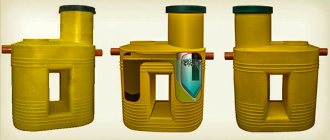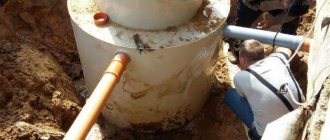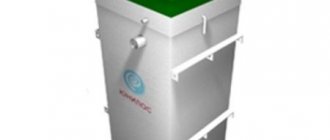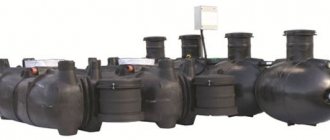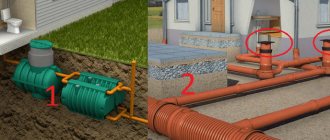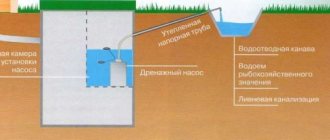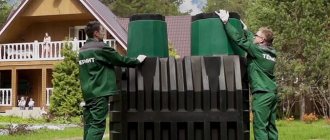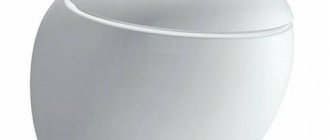Septic tanks of this type are usually made of low-density polyethylene (HDPE), polypropylene (PP), and fiberglass. These treatment plants, like others, have their own characteristics. From this article you will learn:
- What are the advantages and disadvantages of plastic septic tanks.
- How do plastic septic tanks differ from each other?
- How to determine the required volume of a plastic septic tank.
- Is it necessary to add biological products to the septic tank?
- How to properly place a septic tank and filter structures on the site.
- How to properly install plastic septic tanks.
Let us recall that in any septic tank, wastewater is purified through sedimentation and anaerobic digestion - the destruction of organic matter by microorganisms in the absence of atmospheric oxygen. Plastic septic tanks have all the advantages of treatment facilities of this type, and also have a number of advantages over septic tanks made of concrete rings. By the way, you can find out about the pros and cons of such septic tanks here.
What are the advantages of plastic septic tanks
- Energy independence if wastewater is discharged to filtration facilities by gravity.
- Ease of use: plastic septic tanks are suitable for both permanent and temporary or seasonal residence.
- A clear regulatory framework for the construction of septic tanks and filter structures, many years of experience in their use, which means there is less chance of making mistakes when installing an autonomous sewage system.
- The ability to drain almost any human waste into the sewer system. There are few restrictions, including wastewater from flushing drinking water treatment systems, condensate from a condensing boiler, construction chemicals, etc.
- Easy to maintain. Usually, it is necessary to pump out settled sludge from a septic tank no more than once a year. You can do this yourself using a fecal pump. After a few years, the filter structures will need to be flushed. After a few decades, replace them.
- Unlike septic tanks made of concrete rings, plastic ones can be installed in an area with a high groundwater level (GWL), that is, above the design depth of the septic tank base.
- Lightweight plastic septic tanks compared to concrete structures. This allows you to spend less money on transportation, as well as carry out installation faster and with less labor, often performing all the work without the use of lifting equipment.
Common mistakes when installing a polymer septic tank
Often, owners who want to install a plastic sewer sump with their own hands without the help of professionals make annoying mistakes. These, in turn, lead to disruption of the operation of the treatment plant and, accordingly, a decrease in its efficiency. But in the worst case scenario, it may be necessary to dismantle the container and install a new one.
So, common mistakes:
A polymer septic tank is not attached to a concrete slab. It is worth considering that too low specific gravity of the tank does not work in favor of the tank if it is not anchored. That is, even a filled sump will feel like a float in the ground. Therefore, it is possible that the container will be washed out of the ground onto the surface.
- Absence of cement-sand sarcophagus. Such neglect can lead to freezing of the drainage in the tank. Or the septic tank will be pushed out due to seasonal heaving of the soil.
- Using unsifted coarse sand to fill the tank. It is worth considering here that large grains of sand, under the influence of cold in the ground and possible moisture, can behave like a cutting mechanism. That is, under the compression load of the soil, coarse sand at low temperatures is capable of forming microcracks on the walls of the tank, which over time will lead to depressurization of the tank.
Thus, it is clear that a polymer septic tank is a good solution for creating a private sewerage system and wastewater treatment system, but with a competent approach to its installation.
What are the disadvantages of plastic septic tanks
- Relatively low strength of some plastic products.
- Plastic septic tanks may require anchoring.
- The need to supplement septic tanks with soil filtration structures, which take up a lot of space on the site, especially if these are horizontal structures.
- Difficulties with the placement of filter structures at high groundwater levels (less than 1 m from the ground surface). The best option for this situation is to install drainage tunnels in an embankment that will rise above the ground. The height of the embankment is about 120 cm, so such a structure can negatively affect the appearance of the site.
- The energy dependence of the system, if wastewater is diverted from the septic tank forcibly - using a pump.
How do plastic septic tanks differ from each other?
On our market, plastic septic tanks are represented by the trademarks “Tank”, “Evrolos”, “Dochista”, “Termit”, “Rostok”, “Krot”, FloTenk and others.
There are vertical and horizontal septic tanks. The former take up less space on the site, but for them you have to dig a deep pit, which can be problematic to do with high groundwater levels. The latter take up more space, but provide a longer route for the flow of waste from the inlet to the outlet pipe. This improves the quality of wastewater treatment.
Plastic septic tanks come in different shapes. Rounded (cylindrical) products resist compression by soil better than septic tanks in the shape of a cube or parallelepiped.
The most economical septic tanks are made of low-density polyethylene. They are produced using the rotational molding method, making them seamless and therefore completely airtight. This is an absolute plus, especially in the case of an area with high groundwater level. But with this manufacturing method it can be difficult to achieve the same thickness of all walls: for some products it can vary, for example, from 8 to 17 mm. Meanwhile, there is no doubt: the thicker the wall of any plastic septic tank, the more reliable and durable it is (by the way, there are no national standards for the thickness of the walls of plastic septic tanks).
Polyethylene itself does not have high strength and therefore the design of the septic tank requires reinforcement. Otherwise, there is a risk of its deformation due to frost heaving of the soil or the squeezing effect of groundwater. Strengthening measures include stiffening ribs throughout the body and internal partitions: the more of them, the higher the rigidity of the product. Note that such partitions are provided in any plastic septic tanks.
The partitions form chambers that are connected to each other by overflows. Moreover, many manufacturers explain the presence of several chambers as a way to improve wastewater treatment. However, a number of experts argue that this is just a marketing ploy, and partitions are nothing more than structural elements to prevent deformation of the product body. Here we can recall the requirements specified in the main standard for septic tanks - STO NOSTROY 2.17.176-2015 “Autonomous sewerage systems with septic tanks and underground wastewater filtration structures.” According to the standard, septic tanks with a working volume of up to 3 m³ require one chamber to ensure effective wastewater treatment. Please note: polyethylene septic tanks usually need to be anchored to prevent them from being squeezed out by groundwater.
Polypropylene septic tanks also belong to the segment of inexpensive products. They are made by extrusion welding of sheet materials. This method makes it possible to make not only stiffening ribs on the body of the product, but also lugs, loading outlets or other protruding elements that reduce the likelihood of the septic tank floating up. Such septic tanks often do not require anchoring. The strength of polypropylene septic tanks is quite high; the thickness of their walls, as a rule, is at least 8-13 mm, depending on the volume.
But septic tanks made of fiberglass have the highest strength. These are already relatively expensive products that are characterized by very high resistance to soil pressure. They are optimal for installation at great depths (up to 3 m).
In addition to classic septic tanks, there are products on the market that contain a so-called “biofilter”. Such septic tanks should not be confused with aeration units. The biofilter is a load, for example, a brush made of synthetic material or in the form of a container with expanded clay backfill. A colony of anaerobic bacteria forms on the load. According to manufacturers, the biofilter allows you to either improve the quality of cleaning or reduce the working volume of the septic tank while maintaining the same quality of cleaning. It should be borne in mind that the biofilter does not eliminate the need for additional wastewater treatment, while at the same time requiring periodic washing.
Some septic tank models allow the possibility of subsequent addition to a compressor, which saturates the wastewater with oxygen, starting the aerobic cleaning process. Thus, over time, the septic tank can be turned into a budget aeration unit.
Material of manufacture
- Polyethylene
- Polypropylene
- Fiberglass
Each type of plastic has its own characteristics and is designed for a specific function.
Polyethylene
An important point is that polyethylene products are cast using different technologies. And the containers have different characteristics.
Characteristics of a polyethylene septic tank for sewerage:
- Molded from high-strength polyethylene
Resistant to aggressive environments- Does not rust
- Low level of siltation of walls
- The container is monolithic, without seams
- Large selection of volumes
- Installation without any special features
- Installation does not depend on soil characteristics
- Operating temperature -50 to +70 degrees Celsius
The disadvantages include the fact that the material does not tolerate high temperatures, but this is not required for storing wastewater. With prolonged use, cracks may form.
Polypropylene
Polypropylene septic tanks are considered a worthy analogue for concrete tanks and those made of metal.
Installed in sewer systems for temporary and permanent residence.
The characteristics of a polypropylene septic tank for sewerage have several differences from polyethylene:
- The material is resistant to high temperatures, withstands loads of +140 degrees Celsius
- Does not deform at high temperatures
- Increased hardness
The rest of the indicators are similar.
Fiberglass
Fiberglass products are different from previous ones.
These are monolithic containers consisting of several chambers, which are connected by overflow pipes and filters:
The material is very durable, cast with the addition of fiberglass and synthetic resins.- Installation in open ground (no anchoring or concrete foundation required).
- Not subject to corrosion
- Highest resistance to aggressive environments and various chemicals.
- Long service life
The disadvantages include regular pumping and energy dependence in the case of working with aerobes.
In any design, plastic septic tanks outperform their counterparts made from other materials in three main parameters:
- Not very heavy, which makes transportation and installation easier.
- Do not rust and are resistant to aggressive environments
- Septic tanks are sealed, which prevents violation of environmental standards and regulations.
How to determine the required volume of a plastic septic tank
When calculating the volume, you need to take into account, first of all, two factors:
- The norm for water consumption per person is about 200 liters per day (according to SP 30.13330.2012 “Internal water supply and sewerage of buildings”).
- The working volume of the septic tank should be equal to three times the daily inflow with a wastewater flow rate of up to 5 m³ / day (according to STO NOSTROY 2.17.176-2015, SP 30.13330.2012).
Thus, for a family of five people permanently living in the house, a septic tank with a volume of at least 3000 liters (3 m³) is suitable. If guests come to you often and for a long time, then you must not forget about the additional load on the sewer system. When a more accurate calculation of the volume of a septic tank is required, the quantity and type of plumbing equipment with the coefficient of uneven use are also taken into account. The amount of water consumption by plumbing fixtures is indicated in the same SP 30.13330.2012 (Appendix A, Table 1).
An important point: STO NOSTROY clearly states that the volume of a septic tank cannot be less than 2.4 m³. Otherwise, the process of settling wastewater will be ineffective. Some manufacturers ignore this norm, offering plastic “mini-septic tanks” with a volume of 0.45-1.8 m³. When purchasing such products in order to save money, keep in mind: they certainly will not be able to provide the necessary wastewater treatment. Even in the case of a family of two people permanently living in the house.
Experts also pay attention to another important point: unscrupulous manufacturers indicate in advertising materials not the working volume, but the total volume of the septic tank. Therefore, before purchasing, you need to clarify this information, otherwise you risk purchasing a septic tank that will not cope with the waste discharged into it. As a result, underground filtration structures will quickly become clogged (clogged with silt) and fail.
Principles of proper installation of a PVC septic tank
In order to properly install a polymer sewer sump that will work efficiently and for a long time, you need to adhere to several important principles:
- The pit for mounting the tank must exceed the dimensions of the tank by 40-50 cm in depth, and by 30 cm in each direction. This place will subsequently be allocated for concreting the site and creating a sarcophagus for the septic tank.
- A layer of sand 15-20 cm thick should be poured onto the bottom of the pit and compacted well. In this case, the evenness of the base must be checked by level.
- It is imperative to lay a concrete slab at the bottom of the pit. It will eliminate the possibility of washing out the reservoir during the snow melting season.
- In order to create a sarcophagus for a plastic settling well, the walls of the pit can be lined with brick. In this case, the wall thickness can be 12 cm for a round-type tank cross-section, and 25 cm for a rectangular-type septic tank cross-section.
- If the septic tank is installed in the ground, where the groundwater level will exceed the bottom of the tank, then you need to make a special “prance” for the tank. To do this, use a mixture of sand and cement at a ratio of 4:1. The process of pouring a sarcophagus looks like this: first, the tank is filled to 20 cm with water, and then a solution of cement and sand 15-20 cm high is poured around it. Then water is again added to the container to a depth of 20 cm, and the solution is again loaded into the pit. In this way they operate up to the very top of the settling tank.
- For a septic tank that is installed at a depth of more than half a meter, a concrete floor must be provided.
- When installing the tank, you should check the tightness of the connection between the ventilation pipe and the tank.
Is it necessary to add biological products to septic tanks?
There are recommendations to add bioactivators to the septic tank, accelerating the decomposition of organic matter and thereby reducing its volume.
However, experts object to this.
Alexey Melnikov
Septic tanks do not require the addition of any biological products or bioactivators. Moreover, such drugs usually cause enormous harm, since bacteria introduced from outside grow rapidly and suppress the growth of natural bacteria in the septic tank. This means that biological products will have to be used constantly. In addition, the growth of artificially grown bacteria is accompanied by a very intense fermentation process, as a result of which underground filtration structures become clogged with sludge more quickly.
How to properly place a septic tank and filter structures on the site
In the article about septic tanks made of concrete rings, we have already given the requirements for the placement of treatment and filtering facilities. Let's remind them:
- The distance from the septic tank to the house should be at least 5 m, and to the border of the neighboring plot - at least 1 m. If neighbors live on the plot, then in order to avoid conflicts it is better to maintain a distance to its border of at least 4 m.
- The filter well should be at least 8 m away from the house. Filtration fields with a capacity of up to 15 m³/day should be at least 15 m away.
- Treatment and filtering facilities should be located as far as possible from the source of water supply (well or borehole), both your own and your neighbor’s. The minimum distance is 15 m if the structures are located against the flow of groundwater. Or 30 m, if downstream.
- There is no uniform standard for the distance between the septic tank and the reservoir. Everything is determined in each specific case individually depending on the category of the reservoir, its size, etc.
- The distance from the treatment plant to the underground gas pipeline depends on the pressure in it. If the pressure is low (not higher than 0.005 MPa), then this distance should be at least 1 m (according to SP 62.13330.2011 * “Gas distribution systems. Updated edition of SNiP 42-01-2002”, table B.1).
Let us add that in many villages there are internal standards for the location of elements of the external sewage system, and then you need to focus on them.
When thinking about a place for a septic tank and treatment plant, you need to evaluate the topography of the site:
- Treatment and filtering facilities should be located lower in relief in relation to the water supply source so that the flow of groundwater is not directed away from them towards the water intake.
- It is preferable that the treatment plant be located at a point on the site where it will not be flooded with melt water in the spring.
